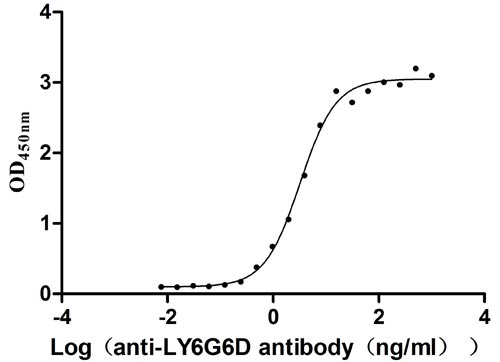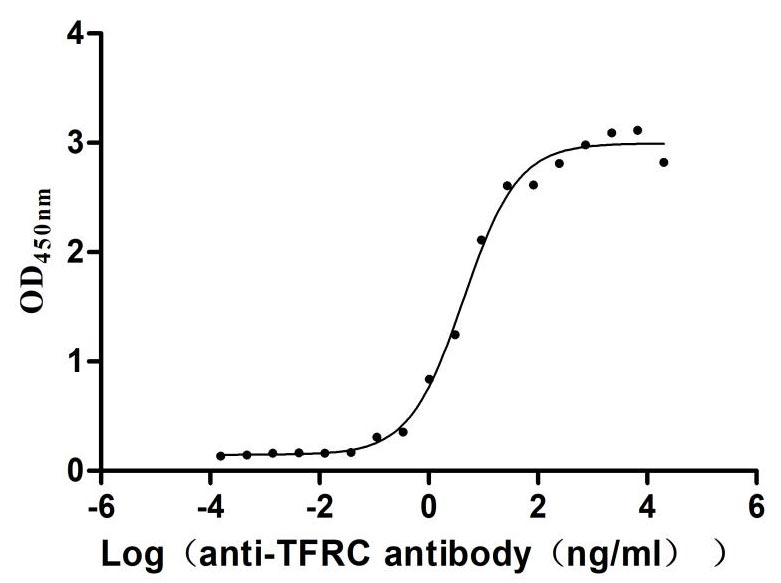Recombinant Mouse Caspase-8 (Casp8)
-
货号:CSB-YP004553MO
-
规格:
-
来源:Yeast
-
其他:
-
货号:CSB-EP004553MO
-
规格:
-
来源:E.coli
-
其他:
-
货号:CSB-EP004553MO-B
-
规格:
-
来源:E.coli
-
共轭:Avi-tag Biotinylated
E. coli biotin ligase (BirA) is highly specific in covalently attaching biotin to the 15 amino acid AviTag peptide. This recombinant protein was biotinylated in vivo by AviTag-BirA technology, which method is BriA catalyzes amide linkage between the biotin and the specific lysine of the AviTag.
-
其他:
-
货号:CSB-BP004553MO
-
规格:
-
来源:Baculovirus
-
其他:
-
货号:CSB-MP004553MO
-
规格:
-
来源:Mammalian cell
-
其他:
产品详情
-
纯度:>85% (SDS-PAGE)
-
基因名:
-
Uniprot No.:
-
别名:Casp8Caspase-8; CASP-8; EC 3.4.22.61) [Cleaved into: Caspase-8 subunit p18; Caspase-8 subunit p10]
-
种属:Mus musculus (Mouse)
-
蛋白长度:Full Length of Mature Protein
-
表达区域:219-376
-
氨基酸序列SE SRTSDKVYQM KNKPRGYCLI INNHDFSKAR EDITQLRKMK DRKGTDCDKE ALSKTFKELH FEIVSYDDCT ANEIHEILEG YQSADHKNKD CFICCILSHG DKGVVYGTDG KEASIYDLTS YFTGSKCPSL SGKPKIFFIQ ACQGSNFQKG VPDEAG
-
蛋白标签:Tag type will be determined during the manufacturing process.
The tag type will be determined during production process. If you have specified tag type, please tell us and we will develop the specified tag preferentially. -
产品提供形式:Lyophilized powder
Note: We will preferentially ship the format that we have in stock, however, if you have any special requirement for the format, please remark your requirement when placing the order, we will prepare according to your demand. -
复溶:We recommend that this vial be briefly centrifuged prior to opening to bring the contents to the bottom. Please reconstitute protein in deionized sterile water to a concentration of 0.1-1.0 mg/mL.We recommend to add 5-50% of glycerol (final concentration) and aliquot for long-term storage at -20℃/-80℃. Our default final concentration of glycerol is 50%. Customers could use it as reference.
-
储存条件:Store at -20°C/-80°C upon receipt, aliquoting is necessary for mutiple use. Avoid repeated freeze-thaw cycles.
-
保质期:The shelf life is related to many factors, storage state, buffer ingredients, storage temperature and the stability of the protein itself.
Generally, the shelf life of liquid form is 6 months at -20°C/-80°C. The shelf life of lyophilized form is 12 months at -20°C/-80°C. -
货期:Delivery time may differ from different purchasing way or location, please kindly consult your local distributors for specific delivery time.Note: All of our proteins are default shipped with normal blue ice packs, if you request to ship with dry ice, please communicate with us in advance and extra fees will be charged.
-
注意事项:Repeated freezing and thawing is not recommended. Store working aliquots at 4°C for up to one week.
-
Datasheet :Please contact us to get it.
靶点详情
-
功能:Thiol protease that plays a key role in programmed cell death by acting as a molecular switch for apoptosis, necroptosis and pyroptosis, and is required to prevent tissue damage during embryonic development and adulthood. Initiator protease that induces extrinsic apoptosis by mediating cleavage and activation of effector caspases responsible for the TNFRSF6/FAS mediated and TNFRSF1A induced cell death. Cleaves and activates effector caspases CASP3, CASP4, CASP6, CASP7, CASP9 and CASP10. Binding to the adapter molecule FADD recruits it to either receptor TNFRSF6/FAS mediated or TNFRSF1A. The resulting aggregate called death-inducing signaling complex (DISC) performs CASP8 proteolytic activation. The active dimeric enzyme is then liberated from the DISC and free to activate downstream apoptotic proteases. Proteolytic fragments of the N-terminal propeptide (termed CAP3, CAP5 and CAP6) are likely retained in the DISC. In addition to extrinsic apoptosis, also acts as a negative regulator of necroptosis: acts by cleaving RIPK1 at 'Asp-325', which is crucial to inhibit RIPK1 kinase activity, limiting TNF-induced apoptosis, necroptosis and inflammatory response. Also able to initiate pyroptosis by mediating cleavage and activation of gasdermin-D (GSDMD): GSDMD cleavage promoting release of the N-terminal moiety (Gasdermin-D, N-terminal) that binds to membranes and forms pores, triggering pyroptosis. Initiates pyroptosis following inactivation of MAP3K7/TAK1. Also acts as a regulator of innate immunity by mediating cleavage and inactivation of N4BP1 downstream of TLR3 or TLR4, thereby promoting cytokine production. May participate in the Granzyme B (GZMB) cell death pathways. Cleaves PARP1.
-
基因功能参考文献:
- These data demonstrate that caspase-8 functions in synovial antigen-presenting cells to regulate the response to inflammatory stimuli by controlling RIPK3 action, and this delicate balance maintains homeostasis within the joint. PMID: 28978351
- Results illustrate the temporal and spatial activation of caspase-8 and -3 in microglia/macrophages occurring upon ischemic stroke and suggest that the expression of these caspases could be used in neuropathological diagnostic work. PMID: 27566702
- inhibition of TAK1 triggered two caspase 8 activation pathways through the induction of RIP1-FADD-caspase 8 complex as well as FLIP cleavage/degradation. PMID: 27685625
- this study identifies a crucial role for caspase-8 in the development of allergic airway inflammation PMID: 27007676
- caspase-8-dependent apoptosis was linked to hepatocellular carcinoma development. PMID: 28898696
- Statistically significant increases in the expression of Fas and caspase-8 were observed, along with other molecules involved in the extrinsic apoptotic pathway such as Dapk1, Traf3, Tnsf12, Tnfrsf1A and Ripk1. PMID: 27709293
- Results suggest that caspase-8 could regulate receptor-interacting protein 3 (RIP3)-mediated necroptosis. PMID: 28039150
- we show that caspase-8 activity promotes cell-intrinsic cytokine expression, independent of its role in cell death in response to Yersinia infection PMID: 27737018
- ING4 might suppress proliferation and enhance apoptosis in human malignant melanoma cells by activating Fas-induced apoptosis in a caspase-8-dependent pathway. PMID: 27070489
- studies have uncovered the combined actions of the NLRP3 inflammasome and caspase 8 leading to IL-1beta maturation and the directionality of IL-1beta in driving disease inPstpip2(cmo)mice. PMID: 27071119
- Chronic TLR Stimulation Controls NLRP3 Inflammasome Activation through IL-10 Mediated Regulation of NLRP3 Expression and Caspase-8 Activation PMID: 26412089
- A20 targets caspase-8 and FADD to protect HTLV-I-infected cells. PMID: 26437781
- Data indicate that receptor-interacting serine-threonine kinase 3 (RIPK3) deletion prevents inflammatory phenotypes in CreLysM (lysozyme M) Casp8fl/fl (caspase 8) mice. PMID: 26471282
- CASP8 deletion did not affect the overall number of microglia expressing the pan specific microglia marker, Iba1 PMID: 26405176
- We observed that NDMP generation was dependent on the extrinsic caspase apoptotic pathway (caspase 3 and caspase 8), cAMP activation of PKA but not of Epac, and on activation of MLCK. PMID: 26707875
- Casp8-dependent migration of enterocytes is likely involved in intestinal physiology and inflammation-related pathophysiology. PMID: 25914458
- NLRP3 inflammasomes directly utilize caspase-8 as both a pro-apoptotic initiator and major IL-1beta-converting protease PMID: 26100631
- The non-receptor tyrosine kinase Tec controls assembly and activity of the noncanonical caspase-8 inflammasome. PMID: 25474208
- RIPK1 indirectly regulates caspase-8 activation, in part via interaction with the ER stress sensor IRE1. PMID: 25476903
- Procaspase-8 mutation also stimulated the growth of head and neck squamous cell carcinoma xenograft tumors. PMID: 24816188
- TNF-alpha induces caspase-8 activation leading to ROS production, PARP-1 activation, and ADP-ribose production in adult ventricular cardiomyocytes. PMID: 24802330
- RIPK3 is an unexpected positive regulator of caspase 8 activity that promotes IL-1beta maturation in bone marrow-derived dendritic cells PMID: 25567679
- DICER1/Alu RNA dysmetabolism induces Caspase-8-mediated cell death in age-related macular degeneration. PMID: 25349431
- an important role for the proapoptotic protease caspase-8 in promoting beta-glucan-induced cell death and NLRP3 inflammasome-dependent IL-1beta maturation. PMID: 25063877
- Caspase-8 promotes NLRP1/NLRP3 inflammasome activation and IL-1beta production in acute glaucoma. PMID: 25024200
- results demonstrate that cell-type specific differences in apoptosis resistance mediated by Casp8 deletion are of significant relevance for the outcome of chronic liver injury PMID: 23928400
- These results suggest that TRAIL inhibits VEGF-induced angiogenesis by increasing caspase-8 activity and subsequently decreasing non-apoptotic signaling functions of procaspase-8, without inducing caspase-3 activation and endothelial cell cytotoxicity. PMID: 24097299
- Uncontrolled TLR activation in a RIPK1-dependent manner is responsible for the enhanced functionality of caspase-8-deficient DCs, because deletion of the TLR-signaling mediator, MyD88, ameliorates systemic autoimmunity PMID: 24808358
- These results clarify the complex roles for RIPK1 in postnatal life and provide insights into the regulation of FADD-caspase-8 and RIPK3-MLKL signaling by RIPK1. PMID: 24813850
- caspase-8 and the RIP kinases are key regulators of macrophage cell death, NF-kappaB and inflammasome activation, and host resistance after Y. pestis infection PMID: 24799678
- RIPK1, FADD, and caspase-8 are required for YopJ-induced cell death and caspase-1 activation PMID: 24799700
- our results reveal FADD and caspase-8 as apical mediators of canonical and noncanonical Nlrp3 inflammasome priming and activation. PMID: 24453255
- neither the unfolded protein response transcription factors XBP1 and CHOP nor the TLR4 adaptor molecule MyD88 is necessary for caspase-8 activation. Instead, both caspase activation and IL-1beta production require the alternative TLR4 adaptor TRIF. PMID: 24489101
- Data indicate that caspase-8 activity is lost upon deletion of c-FLIPL, and p43FLIP rescues caspase-8 activity through Raf1, TRAF2, and RIPK1 association, augmenting ERK and NF-kappaB pathways. PMID: 24275659
- caspase-8 is an integral part of the inflammasome, and this extends the relevance of the inflammasome to cell types that do not express caspase-1. PMID: 23645208
- Data indicate that ASK1 activation stimulated the activity of the transcription factor FoxO3a, which increased the abundance of the apoptosis-promoting adaptor protein TRADD, leading to activation of caspase 8. PMID: 23982205
- In virus-infected cells, a Bax/Bak-independent pathway involves dsRNA-induced innate immune signaling via mitochondrial antiviral signaling (MAVS) and caspase-8. PMID: 24391214
- blockade of caspase-8 activity in T cells improves immunity to L. major infection by promoting increased T helper 1 and T helper 2 responses. PMID: 24072877
- Casp8 comprises a nonapoptotic function during liver regeneration by balancing RIP1, NF-kappaB, and JNK activation PMID: 23728913
- Caspase-8 is a target of miR-874 which is in turn regulated by Foxo3a. PMID: 23828572
- Deletion of Casp8 specifically in murine germinal-center (GC) B cells results in larger GCs & a delay in affinity maturation, demonstrating the importance of apoptosis in GC homeostasis & clonal selection. PMID: 24244021
- proapoptotic chemotherapeutic agents stimulate the caspase-8-mediated processing and release of IL-1beta, implicating direct effects of such drugs on a noncanonical inflammatory cascade that may modulate immune responses in tumor microenvironments. PMID: 24078693
- Although caspase-8 itself is important for pro-IL-1beta synthesis, we hypothesize that the process of caspase-8 recruitment to the inflammasome is not critical for pro-IL-1beta synthesis. PMID: 24123685
- Treatment with TNF-alpha induced formation of neutrophil-derived microparticle by activating caspase 8 and NF-kappaB. PMID: 23850678
- Selective ablation of Casp8 in hepatocytes ameliorates development of nonalcoholic steatohepatitis by modulating liver injury. PMID: 23339067
- Activated beta-catenin can facilitate endosomal trafficking of internalized TNF to suppress caspase-8 activation in colon cancer cells. PMID: 23264463
- Alveolar macrophage-derived tumor necrosis factor (TNF) is required for caspase-8-induced alveolar epithelial dysfunction. PMID: 23487422
- The FADD-CASPASE-8-cFLIP(L) complex functions in the survival of developing mouse embryos. PMID: 22675671
- DP T cell apoptosis following experimental T. cruzi acute infection is dependent on glucocorticoid stimulation, promoting caspase-8 and -9 activation PMID: 23159925
- These results uncover a new mechanism of caspase-8-mediated apoptosis induced by intracellular calcium overload that is dependent on the autophagy-related proteins LC3 and p62 upon hyperactivation of DEG/ENaC channels. PMID: 23239879
显示更多
收起更多
-
亚细胞定位:Cytoplasm. Nucleus.
-
蛋白家族:Peptidase C14A family
-
组织特异性:Expressed in a wide variety of tissues. Highest expression in spleen, thymus, lung, liver and kidney. Lower expression in heart, brain, testis and skeletal muscle.
-
数据库链接:
KEGG: mmu:12370
STRING: 10090.ENSMUSP00000027189
UniGene: Mm.336851
Most popular with customers
-
Recombinant Human Semaphorin-4D (SEMA4D), partial (Active)
Express system: Mammalian cell
Species: Homo sapiens (Human)
-
Recombinant Macaca fascicularis Claudin (CLDN18)-VLPs (Active)
Express system: Mammalian cell
Species: Macaca fascicularis (Crab-eating macaque) (Cynomolgus monkey)
-
Recombinant Human Claudin-4 (CLDN4)-VLPs (Active)
Express system: Mammalian cell
Species: Homo sapiens (Human)
-
Recombinant Human V-set and immunoglobulin domain-containing protein 4 (VSIG4), partial (Active)
Express system: Mammalian cell
Species: Homo sapiens (Human)
-
Recombinant Human Lymphocyte antigen 6 complex locus protein G6d (LY6G6D) (Active)
Express system: Yeast
Species: Homo sapiens (Human)
-
Recombinant Human Trophoblast glycoprotein (TPBG), partial (Active)
Express system: Mammalian cell
Species: Homo sapiens (Human)
-
Recombinant Human Transferrin receptor protein 1 (TFRC), partial (Active)
Express system: Mammalian cell
Species: Homo sapiens (Human)
-
Recombinant Human CD70 antigen (CD70), partial (Active)
Express system: Mammalian cell
Species: Homo sapiens (Human)




















